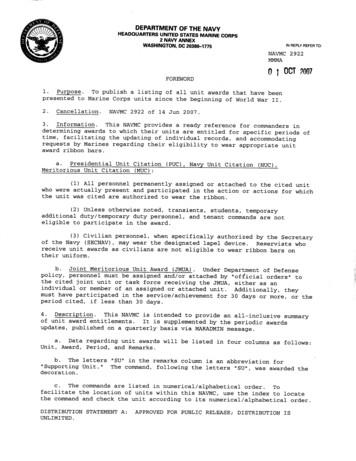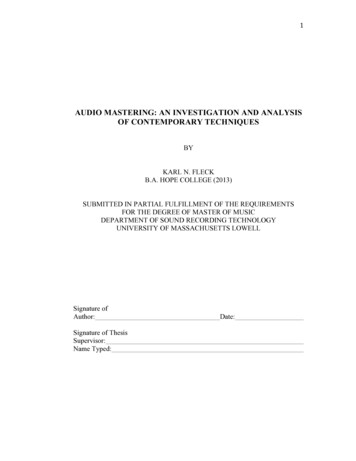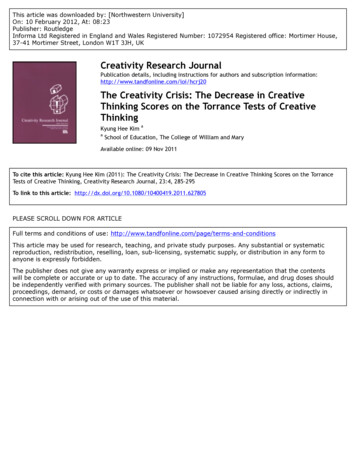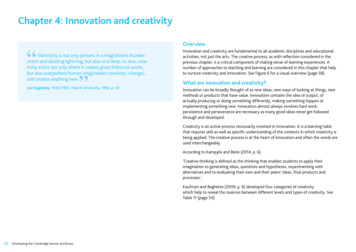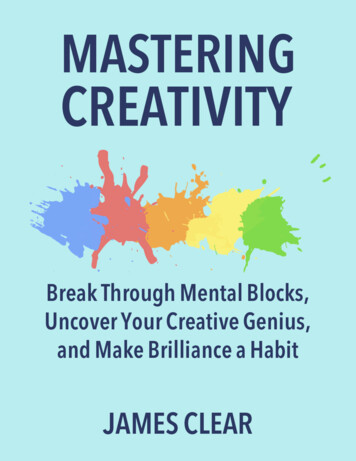
Transcription
1
2MASTERING CREATIVITY, 1st EditionThis guide is free and you are welcome to share it with others.From James Clear:For most of my life, I didn't consider myself to be particularly creative. I didn'tplay a musical instrument (or even know how to read music). I wasn't skilled atdrawing or painting, or really anything that involved the words “arts” or“crafts.”It wasn't until I moved to Scotland and decided to buy a camera to “take somepictures while I'm over there” that I discovered that creativity was somethingthat could be developed. Over the next year, I took more than 100,000 photos.Fast forward to today and I pursue creative tasks all of the time. Every Mondayand Thursday, I publish a new article on JamesClear.com and display creativityas a writer. Occasionally, I'll add some hand-drawn images to those articles.And, of course, I'm still bouncing around the world taking photos and trying totell compelling stories as a photographer.I'm not sure what your creative goals are, but I am sure that you can makeprogress towards them. I wrote Mastering Creativity to share the lessons I'velearned and to express one simple truth about creativity: you have brillianceinside of you, but only if you can find the guts and grit to pull it out of yourself.Let's get to it.
310 THINGS THIS GUIDE WILL TEACH YOU1. How to overcome the mental blocks that prevent creativity.2. How to be creative, even if it's not natural for you.3. How to make time for creative work if you're busy.4. How the world's greatest artists approach the task of creating.5. How to make creating a consistent habit.6. Why smart people should create things.7. One simple trick that makes it easier to be creative.8. How to stay motivated over the long run.9. Why it is important to generate a lot of work to find your creativity.10. And most importantly, how to make these ideas a habit in real life.
4Table of ContentsHow to Find Your Hidden Creative Genius5How Creative Geniuses Come Up With Great Ideas6How to Uncover Your Creative Talent by Using the “EqualOdds Rule”9The Myth of Creative Inspiration12The Difference Between Professionals and Amateurs16The Weird Strategy Dr. Seuss Used to Create His GreatestWork21How to Be Motivated to Create Consistently26Smart People Should Create Things31The Next Step: Where to Go From Here34Sources35
5How to Find Your Hidden Creative GeniusThere is a interesting story about how Pablo Picasso, the famous Spanish artist,developed the ability to produce remarkable work in just minutes.As the story goes, Picasso was walking though the market one day when awoman spotted him. She stopped the artist, pulled out a piece of paper andsaid, “Mr. Picasso, I am a fan of your work. Please, could you do a little drawingfor me?”Picasso smiled and quickly drew a small, but beautiful piece of art on the paper.Then, he handed the paper back to her saying, “That will be one milliondollars.”“But Mr. Picasso,” the woman said. “It only took you thirty seconds to draw thislittle masterpiece.”“My good woman,” Picasso said, “It took me thirty years to draw thatmasterpiece in thirty seconds.” [1]Picasso isn’t the only brilliant creative who worked for decades to master hiscraft. His journey is typical of many creative geniuses. Even people ofconsiderable talent rarely produce incredible work before decades of practice.Let’s talk about why that is, and even more important, how you can reveal yourown creative genius.
6How Creative Geniuses Come Up With GreatIdeasIn 2002, Markus Zusak sat down to write a book.He began by mapping out the beginning and the end of the story. Then, hestarted listing out chapter headings, pages of them. Some made it into the finalstory, many were cut.When Zusak began to write out the story itself, he tried narrating it from theperspective of Death. It didn’t come out the way he wanted.He re-wrote the book, this time through the main character’s eyes. Again,something was off.He tried writing it from an outsider’s perspective. Still no good.He tried present tense. He tried past tense. Nothing. The text didn’t flow.He revised. He changed. He edited. By his own estimation, Zusak rewrote thefirst part of the book 150 to 200 times. In the end, he went back to his originalchoice and wrote it from the perspective of Death. This time—the 200th time—it felt right. When all was said and done it had taken Zusak three years to writehis novel. He called it The Book Thief.In an interview after his book was finally released, Zusak said, “In three years, Imust have failed over a thousand times, but each failure brought me closer to
7what I needed to write, and for that, I’m grateful.” [2]The book exploded in popularity. It stayed on the New York Times best-sellerlist for over 230 weeks. It sold 8 million copies. It was translated into 40languages. A few years later, Hollywood came calling and turned The BookThief into a major motion picture.The Simple Secret to Having Good LuckWe often think that blockbuster successes are luck. Maybe it’s easier to explainsuccess that way—as a chance happening, a fortunate outlier. No doubt, there isalways some element of luck involved in every success story.But Markus Zusak is proof that if you revise your work 200 times—if you find200 ways to reinvent yourself, to get better at your craft—then luck seems tohave a way of finding you.How do creative geniuses come ups with great ideas? They work and edit andrewrite and retry and pull out their genius through sheer force of will andperseverance. They earn the chance to be lucky because they keep showing up.In her Dartmouth Commencement Address, Shonda Rimes shares a strategythat echoes Zusak’s approach Dreams do not come true just because you dreamthem. It’s hard work that makes things happen. It’shard work that creates change Ditch the dream and be a doer, not a dreamer.
8Maybe you know exactly what it is you dream ofbeing, or maybe you’re paralyzed because you haveno idea what your passion is. The truth is, it doesn’tmatter. You don’t have to know. You just have tokeep moving forward. You just have to keep doingsomething, seizing the next opportunity, stayingopen to trying something new. It doesn’t have to fityour vision of the perfect job or the perfect life.Perfect is boring and dreams are not real. Just do.So you think, “I wish I could travel.” Great. Sell your crappy car, buy a ticket toBangkok, and go. Right now. I’m serious. You want to be a writer? A writer issomeone who writes every day, so start writing.How Creativity WorksWe all have some type of creative genius inside of us. The only way to release itis to work on it.No single act will uncover more creative powers than forcing yourself to createconsistently. For Markus Zusak that meant writing and re-writing 200 times.For you, it might mean singing a song over and over until it sounds right. Orprogramming a piece of software until all the bugs are out, taking portraits ofyour friends until the lighting is perfect, or caring for the customers you serveuntil you know them better than they know themselves. You can make any job awork of art if you put the right energy into it.How do creative geniuses come up with great ideas? They work hard at it.
9How to Uncover Your Creative Talent byUsing the “Equal Odds Rule”Paul Erdos was a strange man. He lived out of two suitcases, never learned howto cook his own meals, worked up to 19 hours per day, took amphetaminesdaily and washed them down with caffeine, and gave away nearly all of themoney that he earned. [3]Erdos was also the most prolific mathematician of the 20th century. He wroteor co-authored over 1,500 mathematical articles during his career andpartnered with over 500 different collaborators. As you would expect, hiscontributions to mathematics were significant.Erdos solved a variety of difficult problems. He worked out a proof for theprime number theorem. He led the development of Ramsey theory. Hediscovered the proof for a difficult mathematical riddle known as Bertrand’spostulate. Long story short, Erdos was good. He worked his tail off andadvanced the field of mathematics because of it.And yet, do you know what became of the vast majority of his 1,500 articles andpapers?Nothing. They are long gone. Forgotten. Tucked away in the archives of an oldresearch journal or filed into a box at the bottom of some math lover’s closet.And that is why the story of Paul Erdos is perhaps the best example of what isknown as the Equal Odds Rule.
10Let’s talk about what this rule means and how it can help you uncover yourcreative talent.The Equal Odds RuleIn 1977, a Harvard-trained psychologist named Keith Simonton, developed atheory that he called the Equal Odds Rule.“The Equal Odds Rule says that the average publication of any particularscientist does not have any statistically different chance of having more of animpact than any other scientist’s average publication.” [4] In other words, anygiven scientist is equally likely to create a game-changing piece of work as theyare to create something average that is quickly forgotten.Translated to the world at-large: You can’t predict your own success. Scientists,artists, inventors, writers, entrepreneurs, and workers of all types are equallylikely to produce a useless project as they are to produce an important one.If you believe the Equal Odds Rule, then the natural conclusion is that you’replaying a numbers game. Because you can’t predict your success, the beststrategy is to produce as much work as possible, which will provide moreopportunities to hit the bullseye and create something meaningful. [5]I’ve seen the Equal Odds Rule at play in my own work each month. I write newarticles every Monday and Thursday. I know that if I write a new article everyMonday and Thursday, then that will be about 8 or 9 articles per month onaverage. And if I write 8 or 9 articles per month, then 2 or 3 of them will bedecent.
11Which 2 or 3 will be winners? I have no idea.After sticking to this schedule for almost two years, it has become very clear tome that I am a rather terrible judge of my own work. All I can do is try my besteach time, commit to doing a volume of work, and trust if I stick with theprocess then something useful will find it’s way from my hands to the keyboard.The Willingness to Create GarbagePaul Erdos knew something that all great creators eventually discover: Creativegenius only reveals itself after you’ve shown up enough times to get the averageideas out of the way. Time after time, problem after problem, Erdos keptworking on his craft. 1,500 papers later, it turns out he had some pretty goodideas.If you want to extract your creative genius and make a difference, thenembracing idea behind the Equal Odds Rule is a useful strategy. Sometimesyou’ll create something good. Sometimes you’ll create something useless. Butno matter what, you should always be creating.If you want to make a masterpiece, you have to be willing to create a littlegarbage along the way.
12The Myth of Creative InspirationFranz Kafka is considered one of the most creative and influential writers of the20th century, but he actually spent most of his time working as a lawyer for theWorkers Accident Insurance Institute. How did Kafka produce such fantasticcreative works while holding down his day job?By sticking to a strict schedule.He would go to his job from 8:30 AM to 2:30 PM, eat lunch and then take along nap until 7:30 PM, exercise and eat dinner with his family in the evening,and then begin writing at 11 PM for a few hours each night before going to bedand doing it all over again.Kafka is hardly unique in his commitment to a schedule. As Mason Curreynotes in his popular book, Daily Rituals: How Artists Work, many of the world’sgreat artists follow a consistent schedule.Maya Angelou rented a local hotel room and went there to write. She arrivedat 6:30 AM, wrote until 2 PM, and then went home to do some editing. Shenever slept at the hotel.Pulitzer Prize winner Michael Chabon writes five nights per week from10 PM to 3 AM.Haruki Murakami wakes up at 4 AM, writes for five hours, and then goes for
13a run.The work of top creatives isn’t dependent upon motivation or inspiration, butrather it follows a consistent pattern and routine. It’s the mastering of dailyhabits that leads to creative success, not some mythical spark of genius.Here’s why Daily RoutinesWilliam James, the famous psychologist, is noted for saying that habits andschedules are important because they “free our minds to advance to reallyinteresting fields of action.”An article in The Guardian agreed by saying, “If you waste resources trying todecide when or where to work, you’ll impede your capacity to do the work.”And there are plenty of research studies on willpower and motivation to backup that statement.In other words, if you’re serious about creating something compelling, youneed to stop waiting for motivation and inspiration to strike you and simply seta schedule for doing work on a consistent basis. Of course, that’s easy to say,but much harder to do in practice.Here’s one way of thinking about schedules that may help.
14Permission to Create JunkWeightlifting offers a good metaphor for scheduling creative work.I can’t predict whether or not I’ll set a PR (personal record) before I go to thegym. In fact, there will be many days when I’ll have a below average workout.Eventually, I figured out that those below average days were just part of theprocess. The only way to actually lift bigger weights was to continually show upevery Monday, Wednesday, and Friday — regardless of whether any individualworkout was good or bad.Creative work is no different than training in the gym. You can’t selectivelychoose your best moments and only work on the days when you have greatideas. The only way to unveil the great ideas inside of you is to go through avolume of work, put in your repetitions, and show up over and over again.Obviously, doing something below average is never the goal. But you have togive yourself permission to grind through the occasional days of below averagework because it’s the price you have to pay to get to excellent work.If you’re anything like me, you hate creating something that isn’t excellent. It’seasy to start judging your work and convince yourself to not share something,not publish something, and not ship something because “this isn’t good enoughyet.”But the alternative is even worse: if you don’t have a schedule forcing you todeliver, then it’s really easy to avoid doing the work at all. The only way to beconsistent enough to make a masterpiece is to give yourself permission tocreate junk along the way.
15The Schedule is the SystemDuring a conversation about writing, my friend Sarah Peck looked at me andsaid, “A lot of people never get around to writing because they are alwayswondering when they are going to write next.”You could say the same thing about working out, starting a business, creatingart, and building most habits. The schedule is the system that makes your goalsa reality. If you don’t set a schedule for yourself, then your only option is to relyon motivation.If your workout doesn’t have a time when it usually occurs, then each day you’llwake up thinking, “I hope I feel motivated to exercise today.”If your business doesn’t have a system for marketing, then you’ll show up atwork crossing your fingers that you’ll find a way to get the word out (in additionto everything else you have to do).If you don’t have a time block to write every week, then you’ll find yourselfsaying things like, “I just need to find the willpower to do it.”Stop waiting for motivation or inspiration to strike you and set a schedule foryour habits.
16The Difference Between Professionals andAmateursLast summer, I was speaking with a man named Todd Henry. Todd is asuccessful author and does a great job of putting out valuable work on aconsistent basis.I, on the other hand, do a remarkable job of putting out questionable work onan inconsistent basis. I started to explain this to Todd “Todd, what do you think about writing only when you feel motivated? I feellike I always do my best work when I get a spark of creativity or inspiration, butthat only happens every now and then. I’m pretty much only writing when I feellike it, which means I’m inconsistent. But if I write all the time, then I’m notcreating my best work.”“That’s cool,” Todd replied. “I only write when I’m motivated too. I justhappened to be motivated every day at 8am.”The Difference Between Professionals and AmateursIt doesn’t matter what you are trying to become better at, if you only do thework when you’re motivated, then you’ll never be consistent enough to becomea professional.
17The ability to show up everyday, stick to the schedule, and do the work —especially when you don’t feel like it — is so valuable that it is literally all youneed to become better 99% of the time.I’ve seen this in my own experiences When I don’t miss workouts, I get in the best shape of my life. When I writeevery week, I become a better writer. When I travel and take my camera outevery day, I take better photos.It’s simple and powerful. But why is it so difficult?The Pain of Being A ProApproaching your goals — whatever they are — with the attitude of aprofessional isn’t easy. In fact, being a pro is painful.The simple fact of the matter is that most of the time we are inconsistent. Wehave goals that we would like to achieve and dreams that we would like tofulfill, but we only work towards them occasionally; when we feel inspired ormotivated or when life allows us to do so. It’s just easier that way.I can guarantee that if you set a schedule for any task and start sticking to it,there will be days when you feel like quitting. When you start a business, therewill be days when you don’t feel like showing up. When you’re at the gym, therewill be sets that you don’t feel like finishing. When it’s time to write, there willbe reports that you don’t feel like typing. But stepping up when it’s annoying orpainful or draining to do so, that’s what makes you a pro.
18Professionals stick to the schedule, amateurs let life get in the way.Professionals know what is important to them and work towards it withpurpose, amateurs get pulled off course by the urgencies of life.You’ll Never Regret Starting Important WorkSome people might think I’m promoting the benefits of being a workaholic.“Professionals work harder than everyone else and that’s why they’re great.”Actually, that’s not it at all.Being a pro is about having the discipline to commit to what is important to youinstead of merely saying something is important to you. It’s about startingwhen you feel like stopping, not because you want to work more, but becauseyour goal is important enough to you that you don’t simply work on it when it’sconvenient. Becoming a pro is about making your priorities a reality.There have been a lot of sets that I haven’t felt like finishing, but I’ve neverregretted doing the workout. There have been a lot of articles I haven’t felt likewriting, but I’ve never regretted publishing on schedule. There have been a lotof days I’ve felt like relaxing, but I’ve never regretted showing up and workingon something that is important to me.Becoming a pro doesn’t mean you’re a workaholic. It means that you’re good atmaking time for what matters to you — especially when you don’t feel like it —instead of playing the role of the victim and letting life happen to you.
19How to Become a ProGoing about your work like a pro isn’t easy, but it’s also not as complicated ordifficult as you might think. There are three steps.1. Decide what you want to be good at.Purpose is everything. If you know what you want, then getting it is mucheasier. This sounds simple, but in my experience even people who are smart,creative, and talented rarely know exactly what they are working for and why.2. Set a schedule for your actions.Once you know what you want, set a schedule for actually doing it.Note: Don’t make the same mistake I have made, which is setting a schedulebased on results. Don’t map out how much weight you want to lose each weekor how much money you want to make. “Lose 5 pounds” is not an action youcan perform. “Do three sets of squats” is an action you can perform.You want to set a schedule based on actions you can do, not results that youwant.
203. Stick to your schedule for one week.Stop thinking about how hard it will be to follow a schedule for a month or ayear. Just follow it for this week. For the next 7 days, don’t let distractions getin the way.Setting a schedule doesn’t make you a professional, following it does. Don’t be awriter, be writing. Don’t be a lifter, be lifting. For one week, do the things youwant to do without letting life get in the way. Next week, start again.The Power of the ScheduleIra Glass is the host of the popular radio show This American Life, which isbroadcast to 1.7 million listeners each week. This is the advice Glass gives toanyone looking to interesting, creative work: “The most important thing youcan do is do a lot of work. Do a huge volume of work. Put yourself on a deadlineso that every week or every month you know you’re going to finish one story. Itis only by going through a volume of work that the work you’re making willbe as good as your ambitions.” [6]If you want to do your best creative work, then don’t leave it up to choice. Don’twake up in the morning and think, “I hope I feel inspired to create somethingtoday.” You need to take the decision-making out of it. Set a schedule for yourwork. Genius arrives when you show up enough times to get the average ideasout of the way.
21The Weird Strategy Dr. Seuss Used to CreateHis Greatest WorkIn 1960, two men made a bet.There was only 50 on the line, but millions of people would feel the impact ofthis little wager.The first man, Bennett Cerf, was the founder of the publishing firm, RandomHouse. The second man was named Theo Geisel, but you probably know him asDr. Seuss. Cerf proposed the bet and challenged that Dr. Seuss would not beable to write an entertaining children’s book using only 50 different words.Dr. Seuss took the bet and won. The result was a little book called Green Eggsand Ham. Since publication, Green Eggs and Ham has sold more than 200million copies, making it the most popular of Seuss’s works and one of the bestselling children’s books in history.At first glance, you might think this was a lucky fluke. A talented author plays afun game with 50 words and ends up producing a hit. But there is actually moreto this story and the lessons in it can help us become more creative and stick tobetter habits over the long-run.Here’s what we can learn from Dr. Seuss
22The Power of ConstraintsWhat Dr. Seuss discovered through this little bet was the power of settingconstraints.Setting limits for yourself — whether that involves the time you have to workout, the money you have to start a business, or the number of words you canuse in a book — often delivers better results than “keeping your options open.”In fact, Dr. Seuss found that setting some limits to work within was so usefulthat he employed this strategy for other books as well. For example, The Cat inthe Hat was written using only a first-grade vocabulary list.In my experience, I’ve seen that constraints can also provide benefits in health,business, and life in general. I’ve noticed two reasons why this occurs.1. Constraints inspire your creativity.If you’re five foot five inches tall and you’re playing basketball, you figure outmore creative ways to score than the six foot five inch guy.If you have a one-year-old child that takes up almost every minute of your day,you figure out more creative ways to get some exercise.If you’re a photographer and you show up to a shoot with just one lens, thenyou figure out more creative ways to capture the beauty of your subject thanyou would with all of your gear available.Limitations drive you to figure out solutions. Your constraints inspire your
23creativity.2. Constraints force you to get something done.Time constraints have forced me to produce some of my best work. This isespecially true with my writing. Every Monday and Thursday, I write a newarticle — even if it’s inconvenient.This constraint has led me to produce some of my most popular work inunlikely places. When I was sitting in the passenger seat on a road trip throughWest Virginia, I wrote an article. When I was visiting family for the 4th of July,I wrote an article. When I spent all day flying in and out of airports, I wrote anarticle.Without my schedule (the constraint), I would have pushed those articles to adifferent day. Or never got around to them at all. Constraints force you to getsomething done and don’t allow you to procrastinate. This is why I believe thatprofessionals set a schedule for their production while amateurs wait until theyfeel motivated.What constraints are you setting for yourself? What type of schedule do youhave for your goals?Related note: Sticking to your schedule doesn’t have to be grand or impressive.Just commit to a process you can sustain. And if you have to, reduce the scope.
24Constraints are Not the EnemySo often we spend time complaining about the things that are withheld from us.“I don’t have enough time to work out.”“I don’t have enough money to start a business.”“I can’t eat this food on my diet.”But constraints are not the enemy. Every artist has a limited set of tools to workwith. Every athlete has a limited set of skills to train with. Every entrepreneurhas a limited amount of resources to build with. Once you know yourconstraints, you can start figuring out how to work with them.The Size of Your CanvasDr. Seuss was given 50 words. That was the size of his canvas. His job was tosee what kind of picture he could paint with those words.You and I are given similar constraints in our lives.You only have 30 minutes to fit a workout into your day? So be it. That’s thesize of your canvas. Your job is to see if you can make those 30 minutes a workof art.You can only spare 15 minutes each day to write? That’s the size of your canvas.Your job is to make each paragraph a work of art.
25You only have 100 to start your business? Great. That’s the size of yourcanvas. Your job is to make each sales call a work of art.There are a lot of authors who would complain about writing a book with only50 words. But there was one author who decided to take the tools he hadavailable and make a work of art instead.We all have constraints in our lives. The limitations just determine the size ofthe canvas you have to work with. What you paint on it is up to you.
26How to Be Motivated to Create ConsistentlyTwyla Tharp was born in Indiana and was named after the local “Pig Princess”at the Annual Muncie Fair, who went by Twila.It wasn’t the prettiest of starts, but Tharp turned it into something beautiful.She is widely regarded as one of the greatest dancers and choreographers of themodern era. She has toured across the globe performing her original work. Sheis credited with choreographing the first crossover ballet and she haschoreographed dances for the Paris Opera Ballet, The Royal Ballet, New YorkCity Ballet, Boston Ballet, and many others. Her work has appeared onBroadway, on television, and in films. In 1992, she was awarded a MacArthurFellowship, often called the “Genius Grant”, for her creative work.To put it simply: Twyla Tharp is prolific. The question is, how does she do it?The Power of RitualIn her best-selling book, The Creative Habit, Tharp discusses one of the secretsof her success:I begin each day of my life with a ritual; I wake up at5:30 A.M., put on my workout clothes, my leg warmers,
27my sweatshirts, and my hat. I walk outside myManhattan home, hail a taxi, and tell the driver to takeme to the Pumping Iron gym at 91st street and FirstAvenue, where I workout for two hours. The ritual is notthe stretching and weight training I put my body througheach morning at the gym; the ritual is the cab. Themoment I tell the driver where to go I have completed theritual.It’s a simple act, but doing it the same way each morninghabitualizes it — makes it repeatable, easy to do. Itreduces the chance that I would skip it or do it differently.It is one more item in my arsenal of routines, and one lessthing to think about.Let’s talk about what makes Tharp’s morning ritual so important and how wecan use it to master our own habits.The Surprising Thing About MotivationIf you have trouble sticking to good habits or fall victim to bad ones, then it canbe easy to assume that you simply need to learn how to get motivated or thatyou don’t understand how willpower works.But here is the surprising thing about motivation: it often comes after starting anew behavior, not before. Getting started is a form of active inspiration thatnaturally produces momentum.You have probably experienced this phenomenon before. For example, going
28for a run may seem overwhelming or exhausting just to think about before youbegin, but if you can muster up the energy to start jogging, you’ll often find thatyou become more motivated to finish as you go. In other words, it’s easier tofinish the run than it was to start it in the first place.This is basically Newton’s First Law applied to habit formation: objects inmotion tend to stay in motion. And that means getting started is the hardestpart.I often find this to be true with my articles. Once I begin writing, it’s mucheasier for me to power through and finish. However, if I’m staring at a blankpage, it can seem overwhelming and taxing to take the first step.And this, my friends, is where Twyla Tharp’s morning ritual comes back intothe picture.Rituals Are an On Ramp for Your BehaviorThe power of a ritual, or what I like to call a pre-game routine, is that itprovides a mindless way to initiate your be
The book exploded in popularity. It stayed on the New York Times best-seller list for over 230 weeks. It sold 8 million copies. It was translated into 40 languages. A few years later, Hollywood came calling and turned The Book Thief into a major motion picture. The Simple Secret to Having Go
